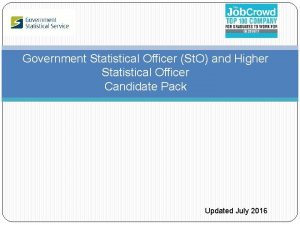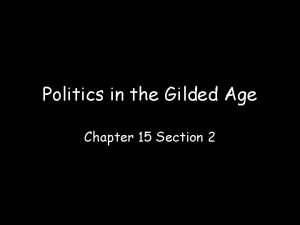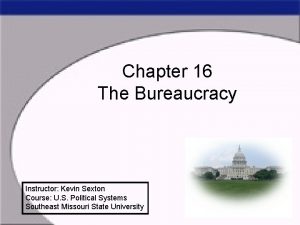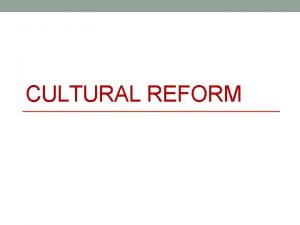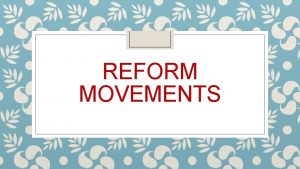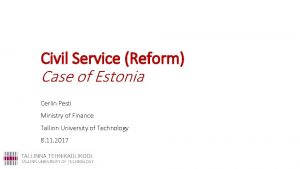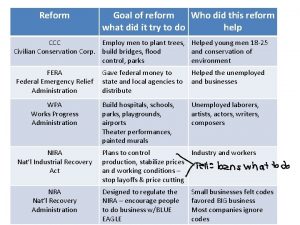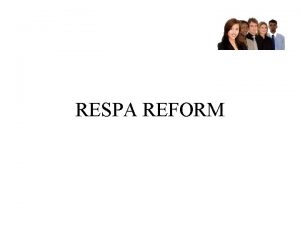Making the Case for Civil Service Reform 2014















- Slides: 15

Making the Case for Civil Service Reform 2014 INTERNATIONAL TRAINING FORUM & EXPO JOHN M. PALGUTA VICE PRESIDENT FOR POLICY PARTNERSHIP FOR PUBLIC SERVICE ipma-hr. org

The Case for Reform THE FEDERAL CIVIL SERVICE SYSTEM HAS NOT KEPT PACE WITH THE CHANGING WORLD • 1949 -ERA GENERAL SCHEDULE IS NOT MARKET SENSITIVE NOR PERFORMANCE SENSITIVE. • HIRING IS STILL TOO SLOW, TOO COMPLEX, AND TOO OFTEN IT DOES NOT IDENTIFY THE BEST PERSON FOR THE JOB TO BE FILLED. • ENSURING ACCOUNTABILITY IS UNEVEN AND “DUE PROCESS” IS UNBALANCED. • THE GOVERNMENT UNDER-INVESTS IN ITS LEADERSHIP.

The Result AN OUTDATED, INEFFECTIVE AND INEFFICIENT SYSTEM…AND A CIVIL SERVICE IN CRISIS

The Attributes of the Ideal Civil Service System Merit-based and diverse Motivated and engaged employees Flexible, adaptive, innovative On par with the HR practices of leading employers Balanced to manage risk, results Politically neutral

Unifying the civil service

Matching the market: Classifying jobs *GS grades are for reference only and may not align with final design or salaries

Matching the market: Setting pay Federal pay-setting process is not credible, suffers from ‘one size fits all’ imprecision, does not reflect realities of labor market(s). POSSIBLE SOLUTIONS Establish a clear pay-setting process based on occupation-specific market comparisons of federal and non-federal salaries and benefits. Compare federal salaries for benchmark professional and administrative occupations. Set salary ranges (minimum, maximum, median) by occupation. Give the executive branch discretion to set and adjust salary ranges for each benchmark occupation within the annual ‘total compensation’ budget. Supplement national rates by current system for locality adjustments.

Performance management Excellent performance is not rewarded, low performance is not addressed, and managers are rarely held accountable for effective performance management. POSSIBLE SOLUTIONS Hold managers accountable for effective performance management and remove barriers that discourage performance accountability. • Require aspiring managers to demonstrate ability to lead people, serve an initial one- year probationary period, and have ongoing training requirements. • Ensure transparency and credibility with agency performance review boards. • Certify effective performance management system before linking to pay. • Maintain separation between performance rating and performance pay processes.

Performance sensitive pay Periodic base pay increases are based primarily on tenure, not performance. POSSIBLE SOLUTIONS Require above average performance for base pay above market, with annual increases based on a transparent, mathematical formula. • Employees receive annual base pay increases linked to performance. • Annual individual pay increases up to market midpoint if performance meets expectations. • Increases above market midpoint only if performance exceeds expectations. • Set agency-wide budget for increases, with oversight by an agency-level performance review board.

Hiring the best and brightest Hiring is too slow, complex and opaque to applicants, imprecise in identifying best-qualified talent. POSSIBLE SOLUTIONS Mount a sustained, government-wide and multi-faceted approach to improve the hiring process. • Give all agencies the same “excepted” hiring flexibilities without compromising on principles like veterans’ preference and merit-based selection. • Leverage technology, state-of-the-art, government-wide assessment tools to effectively and efficiently screen large numbers of applicants. • Create cross-agency best-qualified applicant pools, resume-sharing. • Provide ‘passports’ to facilitate easy reentry with more valuable experience. • Hold managers accountable for how well they bring talent to their organizations.

Accountability and workplace justice Complex, time-consuming complaint/appeal system delays workplace justice, confuses managers and employees, inhibits accountability. POSSIBLE SOLUTIONS Establish ‘one stop shop’ for most employee complaints and appeals to simplify, expedite resolution. • All complaints/appeals filed with a reconstituted MSPB and adjudicated within 120 days. • Includes individual adverse action appeals, discrimination complaints, mixed cases. • Negotiated grievance procedure options and rights remain unchanged. • Single venue for judicial review: U. S. Court of Appeals for the Federal Circuit. • Unions retain exclusive ‘duty of fair representation’ role.

Investing in leadership Senior leadership corps balkanized, relatively immobile, agencycentric, and often ill-prepared to lead the ‘enterprise. ’ POSSIBLE SOLUTIONS Build a single, four-tier Senior Executive Service, with increased responsibility and pay for a top tier reserved for “enterprise” executives. • Encompasses all current senior service systems. • Fill Tier 4 ‘enterprise leadership’ positions with career executives. • Manage Tier 4 with a President’s Management Council (PMC)-led Enterprise Executive Resource Board. • Fill key agency management positions with senior career executives instead of political appointees to provide a long-term perspective and leadership continuity.

A new SES classification system

Implementation Many reform efforts fail to meet expectations because of poor planning and execution; effective implementation is key to success. POSSIBLE STRATEGIES • Strategy must be led by President’s Management Council (PMC), include change management, strategic communications, extensive training. • Provide the Office of Personnel Management (OPM) with the resources needed to conduct major milestone and ‘readiness’ reviews to ensure effective implementation. • Engage stakeholders to inform, support the government-wide strategy and agency- specific plans. • Allow agencies to implement at different pace based on their ‘readiness’ for reform.

Questions? Contact: John Palguta jpalguta@ourpublicservice. org or call (703) 775 -2740
 Best case worst case average case
Best case worst case average case Civil rights and civil liberties webquest
Civil rights and civil liberties webquest Civil service skills
Civil service skills Statistical officer
Statistical officer Higher executive officer
Higher executive officer Civil service competency examples
Civil service competency examples Civil service of ancient han
Civil service of ancient han Pendleton civil service act
Pendleton civil service act Heo dwp jobs
Heo dwp jobs Dan sexton civil service
Dan sexton civil service The pool talent management
The pool talent management Civil service performance appraisal examples
Civil service performance appraisal examples Civil service han dynasty
Civil service han dynasty Civil service fast stream competencies
Civil service fast stream competencies Civil sports club
Civil sports club Scope of bureaucracy
Scope of bureaucracy



